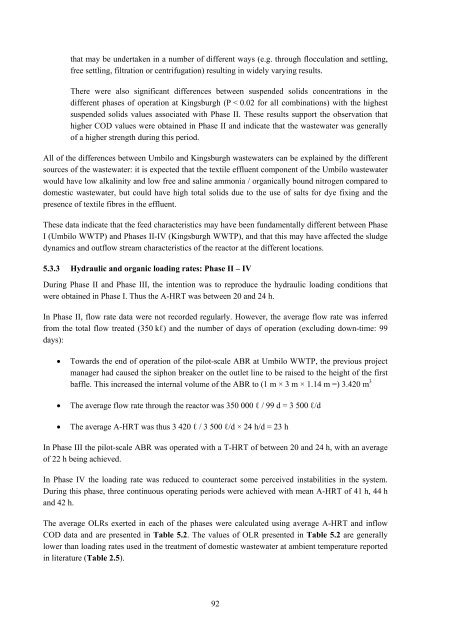analysis of a pilot-scale anaerobic baffled reactor treating domestic ...
analysis of a pilot-scale anaerobic baffled reactor treating domestic ...
analysis of a pilot-scale anaerobic baffled reactor treating domestic ...
Create successful ePaper yourself
Turn your PDF publications into a flip-book with our unique Google optimized e-Paper software.
that may be undertaken in a number <strong>of</strong> different ways (e.g. through flocculation and settling,<br />
free settling, filtration or centrifugation) resulting in widely varying results.<br />
There were also significant differences between suspended solids concentrations in the<br />
different phases <strong>of</strong> operation at Kingsburgh (P < 0.02 for all combinations) with the highest<br />
suspended solids values associated with Phase II. These results support the observation that<br />
higher COD values were obtained in Phase II and indicate that the wastewater was generally<br />
<strong>of</strong> a higher strength during this period.<br />
All <strong>of</strong> the differences between Umbilo and Kingsburgh wastewaters can be explained by the different<br />
sources <strong>of</strong> the wastewater: it is expected that the textile effluent component <strong>of</strong> the Umbilo wastewater<br />
would have low alkalinity and low free and saline ammonia / organically bound nitrogen compared to<br />
<strong>domestic</strong> wastewater, but could have high total solids due to the use <strong>of</strong> salts for dye fixing and the<br />
presence <strong>of</strong> textile fibres in the effluent.<br />
These data indicate that the feed characteristics may have been fundamentally different between Phase<br />
I (Umbilo WWTP) and Phases II-IV (Kingsburgh WWTP), and that this may have affected the sludge<br />
dynamics and outflow stream characteristics <strong>of</strong> the <strong>reactor</strong> at the different locations.<br />
5.3.3 Hydraulic and organic loading rates: Phase II – IV<br />
During Phase II and Phase III, the intention was to reproduce the hydraulic loading conditions that<br />
were obtained in Phase I. Thus the A-HRT was between 20 and 24 h.<br />
In Phase II, flow rate data were not recorded regularly. However, the average flow rate was inferred<br />
from the total flow treated (350 kℓ) and the number <strong>of</strong> days <strong>of</strong> operation (excluding down-time: 99<br />
days):<br />
• Towards the end <strong>of</strong> operation <strong>of</strong> the <strong>pilot</strong>-<strong>scale</strong> ABR at Umbilo WWTP, the previous project<br />
manager had caused the siphon breaker on the outlet line to be raised to the height <strong>of</strong> the first<br />
baffle. This increased the internal volume <strong>of</strong> the ABR to (1 m × 3 m × 1.14 m =) 3.420 m 3<br />
• The average flow rate through the <strong>reactor</strong> was 350 000 ℓ / 99 d = 3 500 ℓ/d<br />
• The average A-HRT was thus 3 420 ℓ / 3 500 ℓ/d × 24 h/d = 23 h<br />
In Phase III the <strong>pilot</strong>-<strong>scale</strong> ABR was operated with a T-HRT <strong>of</strong> between 20 and 24 h, with an average<br />
<strong>of</strong> 22 h being achieved.<br />
In Phase IV the loading rate was reduced to counteract some perceived instabilities in the system.<br />
During this phase, three continuous operating periods were achieved with mean A-HRT <strong>of</strong> 41 h, 44 h<br />
and 42 h.<br />
The average OLRs exerted in each <strong>of</strong> the phases were calculated using average A-HRT and inflow<br />
COD data and are presented in Table 5.2. The values <strong>of</strong> OLR presented in Table 5.2 are generally<br />
lower than loading rates used in the treatment <strong>of</strong> <strong>domestic</strong> wastewater at ambient temperature reported<br />
in literature (Table 2.5).<br />
92
















